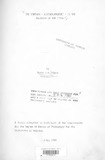| dc.description.abstract | This study focuses on the role of the diviner-prophet, that is,
the emurwon, ih Iteso religion.It invistigates the presence, origin
and functions of the diviner prophet in Iteso society.
The Iteso are found in both Kenya and Uganda., Their language is
called Ateso. The Ateso language has two main "variations" or
"dialects": the version which is spoken by the Northern Iteso and that
spoken by the Southern Iteso. Although the two versions are virtually
the same language,there are differences in spellings, accent and
meani.ngs of seemingly similar and identical words. One of these words
is emurwon which is given the English equivalent as "diviner-prophet".
Emur\von is the Southern Ateso spelling, while Northern Ateso prefers
emuron. The Northern Iteso are found mainly in the former Tesa District
of Uganda. The Southern Iteso are found in former Bukedi District of
Eastern Uganda and in the Amagoro Division of Busia District.
In the course of this study, it was found out that the emurwon
seemed to have two meanings. Some Iteso elders interviewed said that
emurwon means "prophet"; others said "prophet" is ekadlvaran and others
still reversed the meanings of the two words . Further investigations
revealed that often emurwon was both prophet and diviner. After a
careful reflection,they decided to adopt emurwon as the most appropriate
term and to translate it as diviner-prophet. This difficulty is
discussed in the following chapter of the study.
The historical origins and ethnic affiliations of the Iteso are
discussed an chapters one and two. Al.chough t.hey are nwnerically the
second largest ethnic group in Uganda, for a whole district is practically
occupied by-the Iteso, they are in the minority in Kenya. The Iteso
are hardly known in Kenya and the tendency is to confuse them with the
Abaluhya with whom they are neighbours.
Studies which have been done on the Iteso have been mainly
anthropological historical and general,the most notable of which are
by Ivan Karp Lawrence and Webster. A study on their religious beliefs
and on the importance of the prophetic leaders to the Iteso as such has
not been done. This study is an attempt to fill this gap the literature
review on pages 11 - 15 points this out.
Iteso religion is closely interwoven into t.he fabric of the whole
way of life of the Iteso people. Although they did not have written
doctrines about God or a highly structured liturgical life centred on
priests and sanctuaries, nevertheless, God was very real and near to
the people. The way kIteso understood and worshipped God and what they
called him is discussed in chapter three.
The emurwon was a central person in Iteso society and religion.
His importance and functions as prophet, priest, healer and religious leader are treated in the fourth chapter. The importance and influence
of emurwon underwent some decisive changes during and after the subjugation
of the Iteso by the British. The coming of Western missionary christianity
into Tesoland further changed the role and status of the emurwon in
Iteso Society. The encounter of the Iteso with the British colonial
administration and with Christianity is discussed in chapter five.
The concluding chapter, chapter six,is an analysis of the present
status and significance oilthe emurwon in a predominantly christianityconverted
Iteso society. There is a need for the christian churches to
change their understanding of emurwon in view of the continuing influence
they have on the people. Recommendations as to the possibility of what can
he done are given in this concluding chapter.
This study is descriptive rather than analytical, historical
rather than purely theological. Iteso religion falls under the
description of "religions of structure." In order to discover the
contents of these religions, one needs to investigate their
"entire world of events." This world is simply everyday events.
It is a world which integrates all of life into a concrete whole.
Ritual symbolism plays an important part in this integration. It is
hoped that, since it is the first study of this kind that deals with
Iteso religion, the ordinary Itesot who comes across it will be able
to understand it.
The historical aspect of the study situates the Iteso into a
particular time and place. The anthropological aspect gives the
social and cultural structure of Iteso society. Iteso religion
cannot be described in isolation from these aspects. | en |

